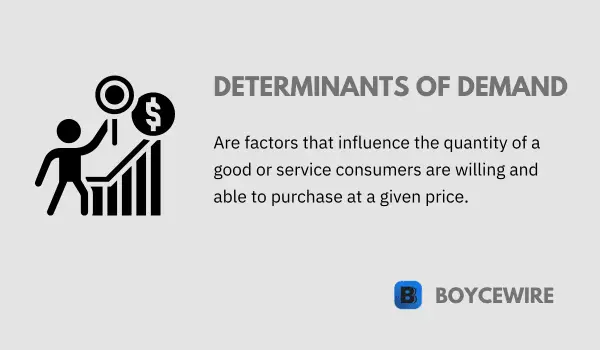Determinants of Demand: Definition & Examples

What are Determinants of Demand?
Demand is a fundamental concept in economics that refers to a consumer’s desire and willingness to pay a price for a specific good or service. It isn’t simply a desire for a product, but it encompasses the ability and readiness to purchase it at the given price. The forces of demand and supply form the backbone of market economies, steering the prices and quantities of goods and services produced and consumed.
Understanding what drives demand is crucial for businesses, economists, and policymakers alike. It enables them to anticipate changes in the market, devise effective strategies, and make informed decisions. This article delves into the determinants of demand, shedding light on various factors that influence the demand for a product or service in a market. Understanding these determinants helps in predicting how demand will change when conditions change, thereby allowing one to stay one step ahead in the dynamic marketplace.
Key Points
- The price of a product or service is a significant determinant of demand. Generally, as the price decreases, demand increases, and vice versa.
- The income level of consumers influences their purchasing power and, consequently, their demand for goods and services. Higher income generally leads to increased demand for normal goods.
- Consumer preferences and tastes play a crucial role in determining demand. Changes in preferences can lead to shifts in demand for specific products or brands.
Understanding Determinants of Demand
‘Demand’ in economic terms refers to the amount of a specific good or service consumers are willing to buy at a given price and time. It represents a consumer’s desire, ability, and willingness to purchase a product. Several elements influence this willingness and ability, known as the ‘determinants of demand’.
The determinants of demand fundamentally shape the demand curve, which is a graphical representation of the quantity of a good consumers are ready to buy at varying prices. Any change in these determinants can lead to a shift in the demand curve, thereby either increasing or decreasing the demand at the same price.
Understanding the determinants of demand is crucial for economic analysis and policy-making as they provide vital insights into market behavior. These determinants help economists predict consumer response to changes in price, income, or other market conditions.
For businesses, recognizing and understanding these determinants is essential. They help businesses anticipate changes in consumer behavior and make informed decisions regarding pricing, marketing, and strategy development in response to changing market conditions.
Examples of Determinants of Demand
The determinants of demand are factors that influence the quantity of a product or service consumers are willing to buy. When these determinants change, they cause a shift in the demand curve either to the left (decreasing demand) or to the right (increasing demand). Here are the primary determinants of demand:
- Income Income directly impacts the purchasing power of consumers. Typically, as income rises, demand for goods and services also increases, and vice versa. However, this isn’t always the case with inferior goods where demand decreases as income rises.
- Prices of Related Goods The prices of substitute goods or complementary goods can influence the demand for a product. If the price of a substitute good increases, demand for the product might increase as consumers switch to the cheaper alternative. On the other hand, if the price of a complementary good increases, demand for the product might decrease since the overall cost of consumption is higher.
- Tastes and Preferences Changes in consumer tastes and preferences can dramatically affect demand. If a product becomes trendy or falls out of favor, demand can spike or decline accordingly.
- Expectations If consumers expect the price of a product to rise in the future, they may increase their demand in the present. Conversely, if they expect the price to drop, they may reduce their current demand and wait for the price to fall.
- Population The size and composition of the population also influence demand. A larger population usually means greater demand. Moreover, changes in the demographic composition, such as an aging population or a higher number of consumers in a particular age bracket, can shift demand for different types of goods and services.
- Government Policies Government policies like taxes, subsidies, and regulations can also impact demand. Policies that increase the cost of goods or reduce consumers’ disposable income can lower demand, while policies that decrease the cost or increase disposable income can boost demand.
Understanding these determinants of demand helps businesses make informed decisions about pricing, production, and marketing, and aids economists and policymakers in predicting market behavior and making economic policies.
Changes in Demand
Changes in demand, also known as shifts in the demand curve, represent a fundamental concept in economics. They occur when a change in one of the determinants of demand causes consumers to buy different amounts at every price.
- Increase in Demand When more of a good or service is demanded at each price level, it results in an increase in demand. This change is depicted graphically as a shift of the demand curve to the right. For instance, a surge in the popularity of a product, a rise in income, or an increase in the price of a substitute good can lead to an increase in demand.
- Decrease in Demand Conversely, when less of a good or service is demanded at each price level, it constitutes a decrease in demand. Graphically, this change is shown as a shift of the demand curve to the left. A decrease in demand could be triggered by factors such as a decrease in the popularity of a product, a drop in income, or a decrease in the price of a substitute good.
It’s important to note that changes in demand differ from changes in quantity demanded. Changes in demand refer to shifts in the demand curve due to changes in non-price determinants of demand, while changes in quantity demanded refer to movements along the demand curve due to changes in the price of the good or service.
Understanding the difference between these two concepts and how demand changes in response to various factors is vital for effective business decision-making and economic analysis.
Impact of Changes in Demand
The impact of changes in demand is multifaceted and extends to both businesses and the broader economy. Here are some key effects:
- Price of Goods and Services An increase in demand, all else being equal, typically leads to an increase in the price of goods and services. Conversely, a decrease in demand can cause prices to fall. This price fluctuation occurs as the market seeks to reach a new equilibrium point where the quantity demanded equals the quantity supplied.
- Production Levels Businesses often need to adjust their production levels in response to changes in demand. When demand increases, companies may need to ramp up production to meet this new demand level. Conversely, when demand falls, they may need to reduce production to avoid overstocking and its associated costs.
- Profitability Changes in demand can significantly impact a company’s profitability. Higher demand can lead to increased sales and potentially greater profits, assuming the company can meet the increased demand effectively. On the other hand, decreased demand may reduce sales and squeeze profit margins.
- Employment Levels Demand changes can also impact employment levels. When demand for a product or service increases and production is ramped up, more workers may be needed, potentially decreasing unemployment levels. However, when demand decreases and production is cut, layoffs may occur, potentially increasing unemployment levels.
- Economic Growth At the macroeconomic level, an increase in demand can spur economic growth as businesses increase production, leading to higher income and employment levels. However, a significant decrease in demand can lead to an economic downturn or recession.
Understanding the potential impact of changes in demand helps businesses and policymakers make informed decisions about production, pricing, and economic policy.
FAQs
The determinants of demand include factors such as price, income, consumer preferences, population, and availability of substitutes or complements.
Price is a significant determinant of demand. Typically, as the price of a product decreases, the quantity demanded increases, and vice versa.
Consumer preferences and tastes play a crucial role in determining the demand for a product. Changes in preferences can lead to shifts in demand for specific goods or services.
Population size can affect demand, as a larger population generally leads to a higher demand for goods and services.
About Paul
Paul Boyce is an economics editor with over 10 years experience in the industry. Currently working as a consultant within the financial services sector, Paul is the CEO and chief editor of BoyceWire. He has written publications for FEE, the Mises Institute, and many others.

Further Reading
 3 Types of Fiscal Policy - There are three types of fiscal policy; neutral, expansionary, and contractionary.
3 Types of Fiscal Policy - There are three types of fiscal policy; neutral, expansionary, and contractionary.  The Consequences of the Industrial Revolution - The consequences of the industrial revolution were far-reaching and included technological innovation, urbanization, labor exploitation, environmental degradation, social changes, and…
The Consequences of the Industrial Revolution - The consequences of the industrial revolution were far-reaching and included technological innovation, urbanization, labor exploitation, environmental degradation, social changes, and…  Discounted Payback Period - The discounted payback period is the length of time required for an investment to recoup its initial cost, considering the…
Discounted Payback Period - The discounted payback period is the length of time required for an investment to recoup its initial cost, considering the… 